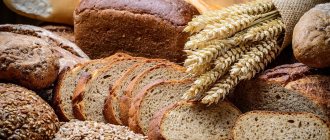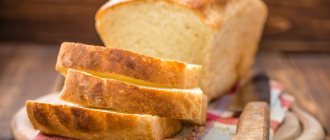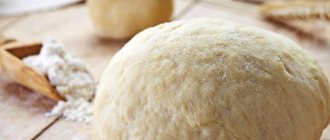Bread is loved by many and is perhaps the most versatile product. That is why it is important to know how to properly store bread so that it remains fresh and soft for as long as possible.
The rate of staling directly depends on the moisture content of baked goods. For example, crackers, biscuits and dryers practically do not go stale
Undoubtedly, the most delicious bread is freshly baked from a home oven or oven. The process of hardening is caused by a change in the structure of starch - its crystallization or, in scientific terms, retrogradation. Let's figure out how to properly store bread at home in the kitchen to slow down this process.
Bread consists of water and flour (starch and gluten). In the oven at high temperatures, starch absorbs moisture, its granules soften and an elastic crumb is formed. During the process of cooling and storage, starch transforms into its original crystalline state, releasing absorbed moisture. The bread loses its softness, elasticity and crumbles easily.
Why does bread quickly become stale, spoil and become moldy?
The loss of moisture that causes bread to go stale begins immediately after baking. Hot products are kept in air until the temperature is equal to room temperature, and then packaged.
If you put a hot bun in a bag, the moisture will continue to evaporate, condensation from the film will fall on the crust, and it will become soggy. Given its carbohydrate-rich composition, bread crumb serves as an excellent environment for fungi and bacteria.
Cooled bread continues to dry out, and the faster the lower the humidity of the room and the higher the temperature. Packaging helps preserve bread in the heat. If for most products refrigeration extends the shelf life, then for bread the decrease in temperature is limited. At 2°C the crumb becomes very dense.
Is it possible to store baked goods in the refrigerator: salvation or mistake?
According to housewives, flour products remain fresh in the refrigerator for 6-7 days.
To do this, it is advisable to follow the rules:
1. Remember that flour absorbs the odors of other foods. Therefore, it is recommended to put baked goods in the refrigerator in a container or bag.
2. It is forbidden to store bread that has not cooled down in the refrigerator compartment. Moisture collects on the walls of the package and the bun spoils.
3. Bread products that are beginning to mold should not be placed in the refrigerator. A lower temperature will not prevent the process. In addition, the pathogenic fungus will spread to the rest of the food.
Low temperature is considered a negative factor of this method. Chilled bread seems tasteless and loses its smell. The bun has to be reheated before eating. Many people don’t like the fact that it dries and hardens because the moisture evaporates faster than at the temperature in the room. And they choose a freezer.
How to properly store baked goods
The subtleties of storage are reflected in GOST 8227-56 for bread and bakery products. The standard was adopted in 1956. Despite improvements in production technology and the practice of improving additives, the standard remains relevant for production and for the home.
The storage location should be:
- permanent;
- clean, dry, well lit;
- away from odorous products and chemicals;
- not infested with insects.
Relative air humidity is assumed to be 75%, temperature - not lower than 6°C. In such conditions, rapid drying will not occur, but there will not be a favorable environment for mold growth.
In what room
The room should be dry, clean and warm.
Bread crumb absorbs foreign odors.
The taste becomes especially unpleasant if a solution with the smell of bleach or petroleum products is spilled nearby. Therefore, bread is delivered in specially equipped vehicles with a sealed body and stored separately from “odorous” products and household chemicals.
The kitchen is in all respects suitable for storing bread, but even here it must be protected from the aromas of garlic and seasonings. Agree that buns with sweet filling and tea loaves with a hint of hot sauce will not appeal to everyone.
What determines the shelf life?
The shelf life of bread depends on many parameters. Here are some main points.
- Compound. This factor is practically the most important one, which contributes to the long-term preservation of bread. Manufacturers, in order to increase the “life span” of bread products, often add preservatives and thickeners to the composition, which do not add health to people. Probably not the best way to preserve bread longer is to buy bread with a shelf life of more than 2 weeks.
- A mixture of different cereal flours. Adding rye flour to wheat flour extends the life of the bread product. It becomes stale more slowly. Additions of fats and sugar help retain moisture in the product, and this also helps to increase its shelf life. But if you add corn or barley flour to wheat flour, then such a loaf will turn out to be stale much faster.
- Technology. The method of preparing bread products is another important factor affecting shelf life. A long fermentation stage and quick dough kneading contribute to a shorter period of staleness.
- Storage temperature . The shelf life of bread in the freezer (-18⁰С…-22⁰С), as well as at very high temperatures (+60..+90⁰С) can be up to several months, retaining its properties.
- Humidity. The optimal humidity for storing baked goods is 75%. When the humidity is lower, the bread goes stale faster, and when the humidity is higher, it begins to mold.
Is it possible to keep different varieties together?
Each person prefers his own type of bread. This is not a whim, but a requirement of the body. Technologists do not recommend mixing together white and black bread, rye and wheat, freshly baked homemade bread with stale bread in storage containers. It is better to place them in individual containers, bags, boxes.
Why you can’t store different types in one place:
- The composition of the microbiological environment depends on the starter or yeast used in baking. Joint storage can cause musty, unpleasant acidic odor in wheat buns;
- The percentage of moisture in some varieties is higher, in others it is lower. In one bread box, the moisture will be evenly distributed throughout the entire volume. For example, dry bread next to a bun will become moist and soft;
- white bread is more susceptible to foreign odors. Its aroma will be lost against the background of rye.
Is it possible to eat an expired product?
You cannot buy or eat expired rolls that have mold on them. This means that the product has lost its beneficial properties and can be harmful to health.
Signs of stale bread:
- it will have an unpleasant odor or no odor at all;
- becomes covered with plaque and mold may appear.
- when squeezed, it will not return to its previous shape.
Unlike moldy bread, the shelf life of stale bread can be extended by about a day. For this reason, it is allowed to use products that have lost moisture but retain their nutritional properties.
Ways to store bread at home
When we come to the store to buy bread, we always see one picture: loaves and buns lie on open wooden shelves. This is not always convenient at home.
How can you keep your bread fresh for as long as possible? After all, we don’t eat what we buy in a day. There are tons of storage options. You just need to choose the one where the soft crumb and crispy crust will last longer.
In a fabric bag
In bags made of linen canvas or cotton, the loaf will retain its natural aroma and taste for a week, but will become stale earlier than in a bread bin. The fabric is good for individual packaging of different types of flour products.
The bags are shaken out when a fresh loaf is placed, and washed once a month or earlier with laundry soap in hot water, as they become dirty.
In foil or plastic bag
Polyethylene and foil prevent moisture loss. The main thing is that the packaging is sealed. The loaf taken out of the bread machine is first cooled and wrapped cold. Bags and foil must be dry and clean.
In a refrigerator
The bread will last for three weeks in the refrigerator. This is convenient if the family does not eat a lot of bread. Cut into portions, it does not mold for a long time and is easily refreshed in the microwave. The bread should be in plastic or foil - there is too much humidity in the refrigerator.
In the freezer
It's good to store in the freezer when you have to leave for a long time. The bread will freeze, but once defrosted in the microwave it will regain its original freshness.
How to freeze correctly:
- portioned pieces are easier to warm without removing the whole bun;
- freshly baked bread is kept until completely cooled and only then frozen;
- Do not freeze the same loaf twice, it will become watery.
In the bread bin
The bread box is preferred for its portability. It can be placed in a convenient place and is easy to clean. The material and shapes are very diverse, so it will fit into any design solution.
Some people prefer to remove all utensils from tables and work surfaces. In this case, you can put the bread bin in a closet or make a shelf for it.
Opponents of this storage method are annoyed by the need to regularly wash the bread bin, so they prefer other options.
On the shelves in the kitchen unit
For those who don’t want to bother with drawers and boxes, the storage shelf will appeal to its ease of cleaning and spaciousness. To protect the surface from greasy stains and stains, you will have to store the rolls in bags and lay down napkins.
The packaging is also useful for protecting against kitchen odors, which are sometimes too intrusive. The closet door will not save you from this.
Containers built into the countertop
A hole of the required size is cut out in the tabletop and a container made of wood, metal, or a wicker basket is inserted. The lid is made in such a way that when closed it is flush with the entire surface. The secret compartment does not take up much space and preserves bread well.
Bread
Bread is a product obtained by kneading flour into dough, loosening the dough by fermentation or other means, molding and baking. Currently, the country's bakery enterprises produce over a thousand varieties of bread products.
Bread products include: baked bread, bakery products, lamb and crackers. Fortifiers have been introduced into the formulation of a number of products: soy and oat flour, dry and condensed whey, vegetable oils, fat-water emulsions, phosphatidic concentrates, which increase the volume of products by 25-35%, improve porosity, lighten the crumb, and extend the shelf life of freshness by 5-5%. 6 hours
Baked bread provides most of the human need for vegetable proteins, minerals (phosphorus, iron, calcium, magnesium), vitamins B1, PP, H, B6, E. In terms of the content of vitamins and ash elements, bread made from low-grade flour is more valuable, and especially wallpaper. The calorie content and digestibility of bread made from premium flour are higher.
Changes during storage
The quality of bread largely depends on the duration and storage conditions. The high humidity of bread and the content of nutrients necessary for the life of microorganisms (soluble carbohydrates, nitrogenous substances) cause a fairly rapid decline in the quality of bread during storage.
During storage, the following changes occur in the bread: deterioration in taste and aroma, loss of some moisture, staling, mold may also occur, and potato disease (typical only for wheat bread).
Taste and aroma are the most important characteristics that affect the appetite, digestibility and nutritional value of bread.
Using modern methods of analysis, it has been established that the taste and aromatic complex of dough, bread and vapors released from the dough during baking form about 250 substances. The aroma of bread, determined by such a combination of substances, is quite well captured by the consumer.
With a larger weight of bread, the baking time lengthens and the aroma of the bread improves. The use of enzyme preparations improves the quality of bread, including its taste and aroma.
When storing bread under normal conditions (at a temperature of 18°C and a relative air humidity of 65%), the content of aromatic substances in the crust initially decreases, and at the same time in the crumb increases as a result of diffusion. During subsequent storage, the content of these substances quickly decreases in the crumb.
The taste and aroma of bread during storage deteriorate mainly as a result of oxidative and hydrolytic changes in lipids and microbiological processes that occur with the formation of various metabolic products that affect the aroma.
Drying out
Drying is a decrease in the weight of bread as a result of the evaporation of water vapor, especially intense in the first moments after baking, and continues during subsequent storage. The drying of bread depends mainly on the air temperature and the duration of storage of the bread. The greatest shrinkage is observed in the first hours of storage, especially at elevated temperatures in storage. All other things being equal, small-piece products with a large total surface area, as well as products with a high initial moisture content, lose more moisture (per unit mass).
Loss of moisture is associated with a decrease in bread weight and a change in crust consistency. Bread drying continues in the back rooms of stores. It depends on the temperature of the crumb. The loss of warm bread is 4-5 times higher than that of cooled bread.
Staleness
Staling is the main process that occurs during storage of bread. At temperatures from 0 to 6°C after 3-5 hours, and at 6-25°C after 10-12 hours, visible signs of staling appear in the bread, which are expressed in a change in the properties of the crumb and crust (which from fragile, dry becomes softer , elastic, and then hard, but not brittle), as well as changes in smell and taste.
The taste and smell of fresh bread is lost and a specific smell and taste of stale bread appears. The rate of staling of different types and varieties of bread is not the same and depends on the type and type of flour from which the bread is made, recipe, cooking method, weight of the product, etc.
This process occurs quite quickly in bread containing an admixture of corn and barley flour. Wheat bread goes stale more slowly, rich and improved bread lasts longer than plain bread; Rye and rye-wheat bread goes stale much more slowly than wheat bread.
The different rates of staling depend on the physicochemical properties of starch and protein substances present in the flour from which the bread is made. In fresh bread, starch grains included in the denatured protein mass are swollen, amorphous, and partially gelatinized.
When storing bread, a change in the structure of the crumb occurs, caused by the retrogradation of gelatinized starch and a change in its properties, the transition of starch grains from amorphous (after baking) back to the crystalline state, compression and reduction of their volume and the transition of part of the bound water to a free state. Grains of partially gelatinized starch are separated from the protein mass, and tiny cracks appear in the pore walls. The resulting free water is partially retained by the crumb protein and partially moisturizes the crust and subcortical layer. This causes softening of the crust in the initial stage of staling. Subsequently, moisture from the crust and subcortical layer evaporates and the crust hardens.
When stale bread is heated to 90-95°C, with a humidity of at least 30%, the starch is re-disaggregated and the soft consistency of the crumb is restored.
Stale bread has reduced elasticity, increased crumbliness, contains less water-soluble substances, and its ability to swell is reduced.
Visible staling can be slowed down by introducing molasses, dextrins, surfactants, emulsified fats, and proteolytic enzymes into the bread recipe. These substances change the structural properties of the crumb and slow down its staling. Some technological methods that increase the porosity and specific volume of bread slow down its staling. Increased processing of the dough during kneading, welding part of the flour, longer ripening of the dough, baking it with sufficient steam moisture contribute to a longer preservation of the freshness of bread.
The rate at which bread goes stale depends on the storage temperature. At a temperature of 0...-2°C it reaches a maximum; with increasing temperature it slows down and stops at 60°C.
Freezing bread and small items at a temperature of -30°C and storing at -18...-20°C is the most effective way to delay and even prevent bread from going stale. The optimal temperature for defrosting bread is 50°C; with it there are no side effects on the starch of the bread crumb.
One of the effective ways to preserve the freshness of bread is to package it in plastic film, varnished cellophane, or waxed paper, which have sufficient mechanical strength and low vapor and moisture permeability. This protects products from excessive drying, ensures the preservation of volatile components of bread, preserves consumer freshness for a longer period, and reduces shrinkage during the expedition of enterprises.
The resulting free moisture under the film does not evaporate, but moisturizes the crust and subcortical layer. Such bread is soft, but crumbly; it still has signs of stale bread: the compressibility of the crumb and the specific swelling in water decreases. However, in bread stored in open trays and boxes, as well as on shelves in one row, there was a loss of moisture from the upper crust and subcrustal layer of crumb, and the hardness of the bread increased; these signs of staleness were more pronounced.
Currently, shelves are used for storing bread in sales areas, and racks, shelves, and containers are used in sales utility rooms. The use of special containers is a progressive method of transporting and trading bread. They are loaded with bread at bakeries and delivered to bakeries by special machines; the bread is stored in these containers and placed on the sales floor.
To preserve the freshness of bread, it is recommended to use covers made of plastic film to cover trays and containers, curtains for wall racks, and blankets to cover bread. Covers must be ventilated once a week for 1-2 hours, washed with warm water and soap and wiped with a 1% solution of acetic acid to prevent the development of mold.
Storing bread in closed cabinets and drawers also eliminates unnecessary losses of grain resources in trade, catering and everyday life.
In areas with a hot climate, where there is a risk of potato disease, bread can be stored in closed containers and covered with polymer films only during the cold season.
Mold occurs when the storage conditions of bread in commercial enterprises are violated as a result of infection with mold spores. Bread removed from the oven does not contain mold fungi, as they die during baking under the influence of high temperature. Infection occurs during storage due to spores in the air. They contaminate the crust and penetrate into the crumb of the bread through cracks and tears that form on the crust, as well as through the pressures that are formed when the products are tightly seated in the oven.
Molds develop quickly at temperatures of 20-40°C with sufficient or increased humidity of the crust and subcortical layer, but can also develop at lower temperatures.
Mold occurs when stored in damp, poorly ventilated areas, as well as due to sudden temperature fluctuations that cause the crust to sweat. In a closed container, bread becomes moldy faster, since water vapor evaporating from the surface of the bread is retained in it. By moistening the crust, they create conditions for mold to grow and penetrate deep into the crumb. As a result of the development of mold, a white, greenish, gray or black coating appears on the crust and crumb of bread. The bread acquires an unusual smell and taste. Molds decompose carbohydrates, fatty acids and form substances harmful to human health.
Rye bread in all types of containers becomes moldy on the fifth day. On city rolls packed in plastic bags, mold appears on the sixth day. The shelf life of bread and bread products does not exceed 1-2 days, so molding is rarely observed if storage conditions are met.
Moldy bread is not allowed for sale or processing for food purposes.
Potato bread disease is caused by spore-forming bacteria (potato bacilli, etc.). Potato sticks may be present in flour. Its spores can withstand heating up to 120°C; they do not die when baking bread and, in favorable conditions, begin to develop during storage. Infection is facilitated by the unsanitary condition of the equipment and premises of bakery enterprises, where a huge number of bacteria that cause disease in bread develop in the remains of dough. The appearance of the disease is favored by the low acidity of the bread and its slow cooling.
The disease most often occurs in summer in wheat bread, especially from second-grade flour, 12-24 hours after baking, and manifests itself in darkening of the crumb. Gray and brown spots form in it, which gradually increase in size and merge into one yellow-brown mass.
Under the influence of potato stick enzymes, starch and bread proteins decompose, and the crumb turns into a dark, viscous, foul-smelling mass. The optimal temperature for the development of potato sticks is 40°C, so rapid cooling of bread and storing it at a temperature of 20-25°C is the most effective method to prevent this disease. However, if the disease has already begun, it continues to develop, albeit slowly and at a lower temperature. This may explain the occurrence of potato disease in the retail chain, where the temperature does not reach 40°C even in summer.
Potato sticks do not tolerate high acidity. Bread with an acidity of more than 6° does not get sick. For this reason, rye bread is not affected by potato disease.
When kneading dough, bakeries are allowed to add 0.1-0.2% acetic acid or 0.2-0.3% calcium acetate to the mass of flour used for baking bread.
Small-piece products (rolls, saiki, bakery trifles, baked goods, etc.) are very rarely affected by potato disease, since they contain relatively less water, cool quickly and are stored for a short time.
High air humidity, lack of ventilation and close packing favor the development of potato disease. Uncollected bread crumbs and flour residues on shelves and in drawers can serve as a source of contamination of bread with potato sticks.
Bread affected by potato disease should not be eaten as it can cause digestive upset. Such bread must be immediately removed from the commercial establishment.
The return of bread affected by potato disease to bakeries is prohibited. The room where the contaminated bread was stored and the equipment with which it came into contact are thoroughly disinfected.
Bread that cannot be used for feed and technical purposes, after activation in the presence of representatives of the sanitary inspection, is burned or buried in the ground to a depth of at least 1 m.
Storage conditions
Bread is stored in dry, clean, bright, whitewashed rooms at a temperature of 20-25°C, but not lower than 6°C and a relative air humidity of no more than 75%.
The presence of any other goods is not allowed in the room where bread is stored.
In retail trade enterprises, bakery products are stored in utility rooms (pantries) and in workplaces on the sales floor, where wall-mounted equipment is used.
Maximum shelf life in retail trade enterprises, counting from the moment the products leave the oven, h:
- rye and rye-wheat bread with iso-butane and peeled flour - 36;
- wheat and rye-wheat bread from high-quality flour - 24;
- small piece and butter products - 16;
- small piece products in plastic film bags - 4
Traditional option - bread box
Most housewives prefer a bread box. It justifies its purpose both in a small kitchen and in a spacious kitchen-living room. Which bread bin is best to choose based on design and material of manufacture is a matter of individual preference.
Material selection:
- made of plastic - as a neutral composition, it retains moisture and protects against foreign odors. These same qualities contribute to the appearance of mold and air stagnation. Treatment with acetic acid for prevention is recommended once a week;
- made of wood is the best bread box in terms of shelf life. If the wood has not been treated with impregnations or varnish, it does not produce foreign odors, but, on the contrary, accumulates them. To clean the top layer and disinfect it, treat it with boiling water once a month. Naturally, dry cleaning is carried out as needed;
- made of birch bark - an original type of bread bin, retains all the advantages of wood;
- made of ceramics - dishes made of neutral material best preserve the taste and aroma of any product. A ceramic pot or vase will keep the loaf fresh for several days. Unglazed ones are difficult to keep clean; glazed ones are not suitable for long-term storage, as they do not allow air to pass through;
- made of stainless steel - for those who prefer simplicity and conciseness, as well as for clean people. Metal can simply be wiped with a clean cloth. It doesn’t hurt to cover the bottom with a clean cotton or linen cloth and place a wooden board to preserve the taste of the bread;
- made of glass - bread bins protect against staleness and look stylish; in a small kitchen they do not burden the space. They are absolutely sealed, so it is necessary to prevent the development of fungus;
- made of wicker - in such a container the bread will remain soft for a maximum of a couple of days. Crumbs get stuck in the cracks. To keep the utensils clean, cover them with a napkin, wash them with warm water and treat them with boiling water or vinegar.
How to restore freshness to a stale product
In order to restore freshness to stale bread, you can use the following tips:
- Sprinkle clean water on the loaf, put it in the oven for a few minutes at a temperature of 100-120°C;
- put the product cut into pieces in a colander, cover with a lid and hold over water brought to a boil for 2-3 minutes;
- warm up the loaf, use a thermos or thermal mug with a wide neck for further storage.
Dried bread can also be used as crackers. In this form, it will be useful when losing weight to remove waste and toxins from the body.
Bread is a valuable universal product with a short shelf life. In order to keep it fresh for as long as possible, it is important to responsibly select materials for packaging and other storage conditions. The shelf life of bread will also vary depending on its type.
How do you prefer to store baked goods? Share your experience in the comments, repost.
Kinds
The smaller the area, the more important it is to organize your workspace correctly. We have to decide how to save space in the kitchen. Modern bread bins look good on the dining table, but sometimes they just get in the way.
To stop worrying about where to put the bread bin, you can practically arrange storage built into the kitchen. This could be a regular shelf with a door in the top tier of the unit, where packaged rolls are placed or boxes of sliced meats are placed.
A simple solution is an open shelf for installing a compact bread bin.
In lower cabinets it is convenient to use a drawer for this purpose. Be sure to make a metal, wooden or plastic lid.
The bread bin in the kitchen interior can be hanging. Choose roof rails, regular screws or hooks.
One of the options for saving kitchen space is corner placement. Carefully choose a section of the wall away from the stove and sink.
An old bread box will turn into an exclusive interior detail if you choose a creative idea. You can simply prime and paint, use decoupage on metal, burning and painting on wood.
The procedure for cleaning the “grain place”
The bread shelf and bread bin are washed regularly and dried thoroughly.
Moisture is the enemy of any bread, rye or wheat, unleavened or rich.
Both in containers and in cabinets it is necessary to carry out regular antiseptic treatment with neutral agents - detergents without fragrances, laundry soap, baking soda, vinegar.
Secrets on how to keep bread fresh longer?
To keep bread fresh and tasty longer, our ancestors knew some secrets:
- A lemon peel placed in the bread box will add a pleasant aroma to the bread.
- To prevent bread from becoming stale quickly, you need to put a piece of apple or raw potato in the bread bin.
- To prevent the bread from becoming moldy, you need to wrap a handful of salt in a cloth and put it in the bread bin.
- Bread will not mold in a bread bin made of birch bark or juniper - these types of wood are good antiseptics.
- Place only completely cooled bread into the bread bin.
- To prevent bread from going stale longer, do as our ancestors did: cut the bread in half, cut off a piece of bread from the middle, and press the remaining 2 pieces of bread together with the cuts, and store it that way.
- Bread can be stored in a three-layer bag (the top and inner layers are made of cloth, the layer in the middle is made of plastic). In such a bag, bread does not go stale for 3-4 days.
- Bread will go stale less if you rinse a cloth bag in a saline solution, dry it, and store the bread in it.
Bread stays fresh for a long time if stored in a linen bag
How to revive bread that is going stale: 10 ideas for stale bread
Staleness is not yet a reason to throw away bread. If it has not had time to dry completely, you can try to return the structure to its normal softness. Any moldy piece will have to be thrown away.
How to revive bread:
- moisten in water, place in a bag, container or mold with a lid. Place in the oven or microwave for a few minutes. The amount of water depends on the callousness. For something that has been in the refrigerator for a couple of days, spraying the crust will suffice;
- steam the pieces for a couple of minutes in a colander in a bathhouse. Serve or seal tightly, otherwise the moisture will evaporate quickly.
Rusks are suitable for preparing some dishes and drinks. 10 ideas for stale or dried out bread:
- Rusk bowl
The suharnitsa was baked in Russian ovens. Beat 3 eggs and 3 tbsp. milk. Grease a baking dish with oil, where 100 g of rye or wheat crackers are placed. Pour in the egg-milk mixture and after standing for half an hour, bake for half an hour in a well-heated oven.
- Breading
Crushed wheat crackers are used as a breading coating for cutlets and chops. It is important that they are made from bread without seeds, fruits or other additives. Stale bread is grated and stored in the freezer or dried in the oven.
- With dumplings
White bread crackers are an excellent addition to dumplings with cottage cheese. For this purpose, the bread is finely chopped or grated on a coarse grater and dried. Add to the finished dish, pouring over melted butter.
- Kvass
Kvass on rye crackers is prepared for okroshka or drinking, to which raisins and additional sugar are added. Stale rye bread should be cut into pieces about 1 cm in size and dried until dark at 180°C.
200 g of crackers, pour 3 liters of boiling water, add 3 tbsp. sugar, stir and wait for it to cool to room temperature. 20 g of fresh yeast are diluted in a glass of warm rusk water and left until the foam cap rises. Mix with the rest of the solution, cover with a cloth and place in a warm place for 2 days. Strain the kvass into a jar. For drinking, add 5-6 raisins and leave for another day.
- Cake for tea
Slice bread or dried loaf. Place the pieces in pairs, sandwiching them with any jam. Spread butter on top and cut into strips. Oil is dipped in sugar and placed on a sheet. Bake at 200°C for 10 minutes.
- Toast
Dried pieces of bread are dipped in eggs beaten with milk and fried on both sides. A mixture of 1 egg and a glass of milk is made sweet (sugar, honey to taste) or spicy (salt, garlic, pepper).
- Chicken salad
Cut into pieces 300 g of boiled chicken fillet, 200 g of hard cheese, 300 g of canned corn, 200 g of crackers. Season with 200 g of mayonnaise and mix. Leave in the refrigerator for a couple of hours to soak the crackers, then serve.
- Dessert with fruits
Rusks are laid out in layers in a deep form, alternating with flat-cut apples or other fruits. Fill each layer of crackers with a beaten mixture of eggs and sugar. To make the cake more tender, leave it on the table for 40 minutes before putting it in the oven.
- Pancakes
Mix 2 cups of grated crackers and a glass of milk, leave to swell. Add 2 eggs, finely chopped onion. Fry in oil like pancakes. Serve as a separate dish with sour cream and as a side dish for meat.
- Rum cake
Fry 2 tablespoons of flour in 2 tablespoons of butter until golden brown. Pour in 1.5 cups of milk, add 2 tablespoons of sugar and heat until it thickens. Mix the mass with 500 g of grated crackers (preferably from butter rolls), a spoonful of rum or cognac, add a spoonful of instant coffee, nuts, and candied fruits if desired.
Form a rope and cut into pieces. Keep in a cold place for an hour and cover with chocolate glaze.
At what temperature is bread stored?
It has been noticed that baked goods will quickly become stale at +2°C. When the bread is fresh, its moisture content is close to 50%, and when the moisture evaporates, it becomes stale. The evaporation process is more intense at +2°C. This temperature indicator is close to what is kept in the refrigerator, and there the baked goods quickly become stale. It is better to store it in the freezer or bread bin. This is why you should not store bread in the refrigerator if other storage methods are available.
In order not to experience difficulties with questions of where and how to store bread, you should purchase it in quantities necessary for consumption 1 - 2 days in advance.
Lifehacks for young housewives
How to keep bread fresh, just brought from the store or baked in a bread machine:
- Place a slice of lemon in the bread box. Lemon will give a pleasant aroma and protect against shrinkage, but after 2-3 days it is replaced because it begins to deteriorate.
- A piece of raw potato can humidify the air. For the method to work, the potatoes are renewed every day. Do not allow bread to come into contact with wet root vegetables.
- A handful of salt in the bread box will absorb moisture and protect against mold.
- Place in a fabric bag and then in a plastic bag.
- Cut the loaf in half and cut out a slice from the middle. Fold the remaining pieces again until the crumb is covered.
Real bread, made according to traditional recipes, has been and will be an honored guest on the table. It is not only satisfying, but also contains B vitamins. Since the taste and benefits are preserved only with proper storage, baked goods are given a separate place in the kitchen. It is advisable to buy the product in limited quantities. If you rarely get to the store, you can keep bread in reserve in the freezer.
Did you like the article? Tell your friends about it:
1 3
What does SanPin say about the storage of bakery products?
The Russian Federation has established the following sanitary rules and standards for the storage of bread products:
Bread is stored in suitable rooms: light, clean, ventilated and dry. Isolated from heating devices and cold air. Mold and wet stains are not allowed on the walls.
Products are stored in open or closed containers placed on mobile racks. Shelves, trays, racks are made from materials approved by the Ministry of Health: metal, wood, plastic.
It is prohibited to store goods that differ in composition and smell in warehouses for flour products.
For shelf life, the loaves are packaged.
Shelf life of bread products:
- wheat – 3 days in packaging, 1 day without packaging;
- rye – 5 days;
- Borodinsky - 36 hours;
- wheat-rye – 4 days;
- wheat loaf – 1-3 days.
Since 2022, factory packaging for baked goods contains sorbic acid. A natural preservative protects against mold and increases the time of use.
How to recognize a delay?
To avoid buying spoiled bread, pay attention to the presentation:
- the bun should be smooth and without dents;
- take its original shape after squeezing;
- have a bready smell;
- be free of traces of mold and dark deposits.
The presence of one of the listed signs indicates that the product is expired. You can't buy or eat this.











